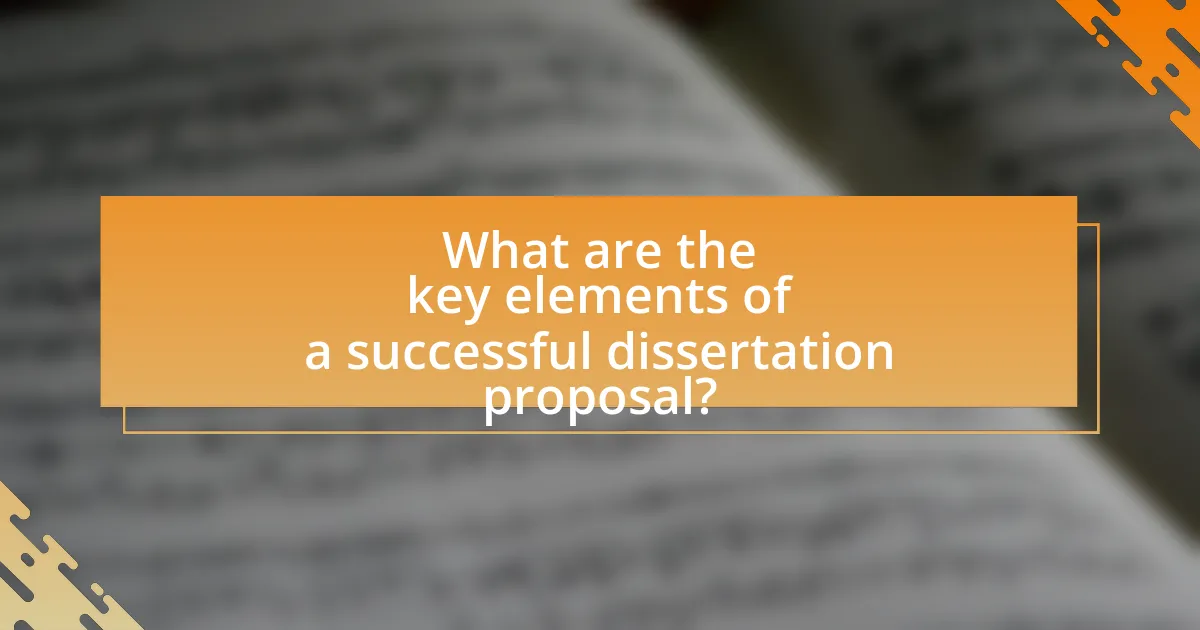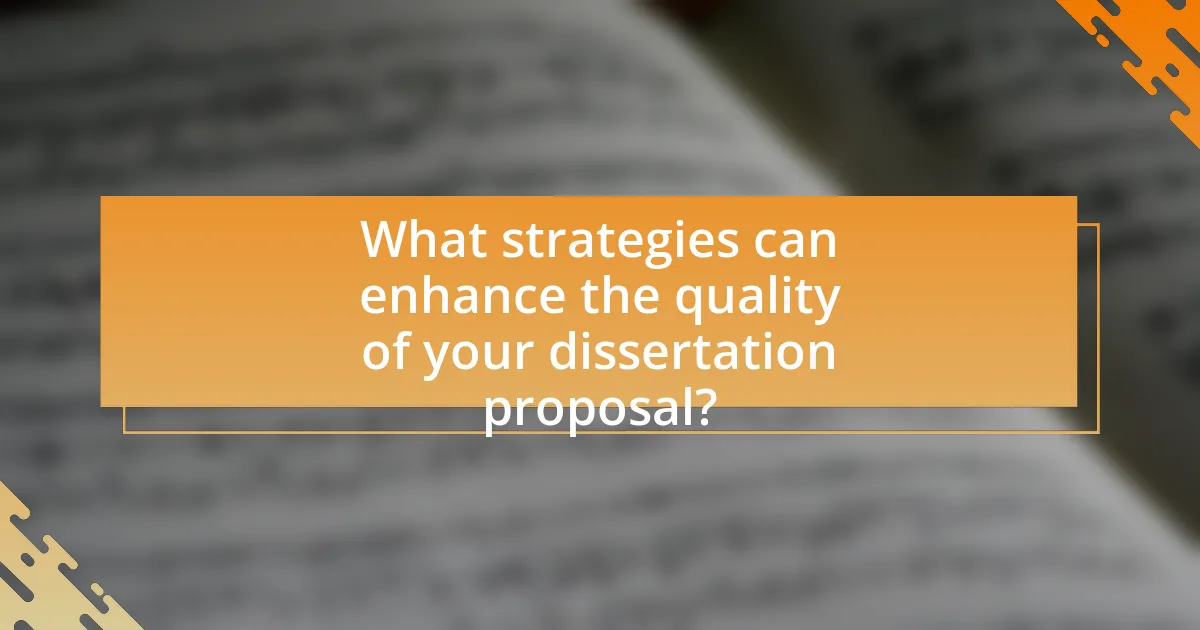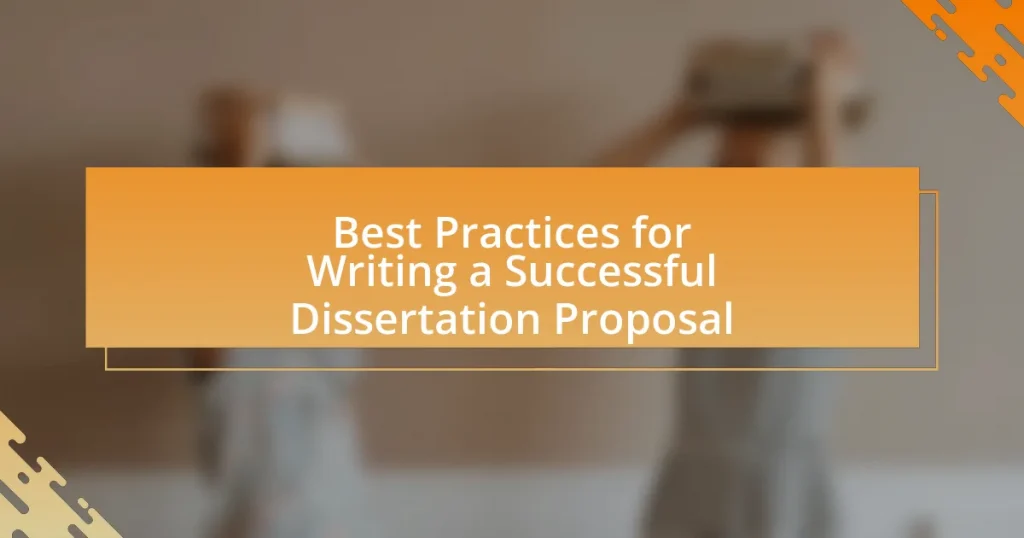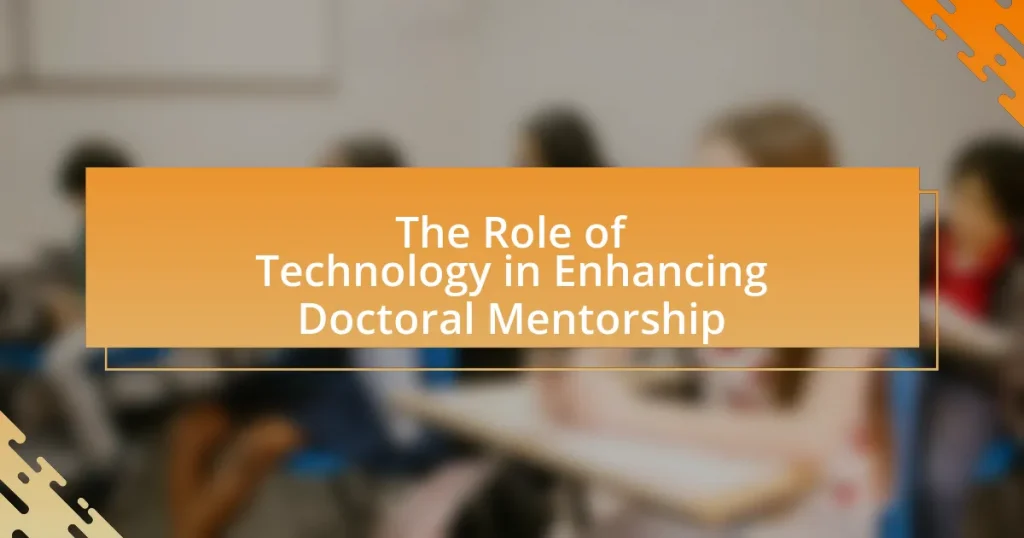The article focuses on best practices for writing a successful dissertation proposal, emphasizing key elements such as a clear research question, comprehensive literature review, well-defined methodology, and detailed timeline. It outlines the importance of defining a relevant research problem, conducting a thorough literature review, and justifying the chosen methodology to enhance the proposal’s clarity and feasibility. Additionally, the article discusses effective structuring of the proposal, common pitfalls to avoid, and resources available to support the writing process, ensuring that the proposal meets academic standards and increases the likelihood of approval.

What are the key elements of a successful dissertation proposal?
A successful dissertation proposal includes a clear research question, a comprehensive literature review, a well-defined methodology, and a detailed timeline. The research question guides the study’s focus and significance, ensuring it addresses a gap in existing knowledge. A comprehensive literature review situates the research within the current academic discourse, demonstrating familiarity with relevant studies and theories. The methodology outlines the research design, data collection, and analysis methods, providing a roadmap for how the research will be conducted. Finally, a detailed timeline helps to organize the research process and set realistic deadlines, ensuring that the project remains on track. These elements collectively enhance the proposal’s clarity and feasibility, increasing the likelihood of approval.
How do you define the research problem in a dissertation proposal?
To define the research problem in a dissertation proposal, identify a specific issue or gap in existing knowledge that the research aims to address. This involves conducting a thorough literature review to understand the current state of research and pinpoint areas that require further investigation. For instance, a well-defined research problem should be clear, focused, and researchable, allowing for the formulation of research questions or hypotheses. According to Creswell (2014), a precise research problem guides the study’s direction and methodology, ensuring that the research contributes valuable insights to the field.
What criteria should the research problem meet?
The research problem should meet the criteria of being clear, significant, and researchable. A clear research problem articulates the issue in a straightforward manner, allowing for focused investigation. Significance ensures that the problem addresses a gap in existing knowledge or has practical implications, which is essential for contributing to the field. Researchability indicates that the problem can be investigated through empirical methods or theoretical frameworks, ensuring that it can be effectively studied within the constraints of time and resources. These criteria are supported by academic standards that emphasize the importance of clarity, relevance, and feasibility in research design.
How can you ensure the research problem is relevant and significant?
To ensure the research problem is relevant and significant, conduct a thorough literature review to identify gaps in existing research. This process reveals areas where further investigation is needed, demonstrating the problem’s importance. For instance, a study by Creswell (2014) emphasizes that addressing underexplored topics can lead to meaningful contributions in the field. Additionally, engaging with stakeholders and practitioners can provide insights into real-world issues, further validating the significance of the research problem.
What role does the literature review play in a dissertation proposal?
The literature review in a dissertation proposal serves to contextualize the research by summarizing existing knowledge and identifying gaps that the proposed study aims to address. This section critically evaluates relevant scholarly works, demonstrating the researcher’s understanding of the field and establishing the significance of the proposed research. By synthesizing previous studies, the literature review provides a foundation for the research questions and methodology, ensuring that the proposal is grounded in established scholarship. Furthermore, it highlights the originality of the proposed research, which is essential for justifying its contribution to the academic community.
How do you conduct a comprehensive literature review?
To conduct a comprehensive literature review, systematically gather, analyze, and synthesize existing research relevant to your dissertation topic. Begin by defining clear research questions or objectives to guide your search. Utilize academic databases such as Google Scholar, JSTOR, and PubMed to find peer-reviewed articles, books, and theses.
Next, apply specific keywords and phrases related to your topic to ensure a thorough search. Organize the collected literature by themes, methodologies, or chronological order to identify trends and gaps in the research. Critically evaluate the quality and relevance of each source, considering factors such as the credibility of the authors and the publication date.
Finally, summarize the findings in a structured format, highlighting key insights and how they relate to your research questions. This process not only establishes a solid foundation for your dissertation but also demonstrates your understanding of the existing body of knowledge in your field.
What are the common pitfalls to avoid in the literature review?
Common pitfalls to avoid in the literature review include failing to conduct a comprehensive search, which can lead to missing key studies that inform the research question. Additionally, a lack of critical analysis of the sources can result in superficial understanding and misrepresentation of existing literature. Another pitfall is the tendency to include irrelevant studies, which dilutes the focus of the review. Furthermore, not organizing the literature thematically or chronologically can create confusion for readers. Lastly, neglecting to update the literature review with the most recent studies can render the research outdated. These pitfalls can undermine the quality and credibility of the dissertation proposal.
Why is a clear methodology essential in a dissertation proposal?
A clear methodology is essential in a dissertation proposal because it outlines the specific procedures and techniques that will be used to conduct research, ensuring the study’s validity and reliability. This clarity allows reviewers to assess the feasibility and appropriateness of the proposed research methods, which is critical for obtaining approval. Furthermore, a well-defined methodology demonstrates the researcher’s understanding of the subject and their ability to systematically address the research questions. According to the American Psychological Association, a robust methodology is fundamental for replicability, which is a cornerstone of scientific research.
What types of research methodologies can be used?
Quantitative, qualitative, and mixed methods are the primary types of research methodologies that can be used. Quantitative research focuses on numerical data and statistical analysis to identify patterns and test hypotheses, often employing surveys or experiments. Qualitative research emphasizes understanding human behavior and experiences through interviews, focus groups, or content analysis, providing in-depth insights. Mixed methods combine both quantitative and qualitative approaches, allowing for a comprehensive analysis of research questions. This classification is widely recognized in academic literature, such as Creswell’s “Research Design: Qualitative, Quantitative, and Mixed Methods Approaches,” which outlines these methodologies and their applications in research.
How do you justify your chosen methodology?
The chosen methodology is justified by its alignment with the research objectives and the nature of the study. For instance, qualitative methods are appropriate for exploring complex phenomena, while quantitative methods are suitable for testing hypotheses. This alignment ensures that the methodology effectively addresses the research questions. Additionally, previous studies, such as those by Creswell (2014) in “Research Design: Qualitative, Quantitative, and Mixed Methods Approaches,” demonstrate that selecting a methodology based on the research context enhances the validity and reliability of findings. Thus, the justification rests on both theoretical frameworks and empirical evidence supporting the chosen approach.

How can you effectively structure your dissertation proposal?
To effectively structure your dissertation proposal, begin with a clear title that reflects your research focus. Follow this with an introduction that outlines the research problem, objectives, and significance of the study. Next, include a literature review that summarizes relevant research and identifies gaps your study will address.
After the literature review, present your research methodology, detailing the design, data collection methods, and analysis plan. This section should demonstrate the feasibility and appropriateness of your approach.
Subsequently, outline the expected outcomes and contributions of your research, emphasizing how it will advance knowledge in your field. Finally, include a timeline for your research activities and a bibliography of key sources. This structured approach ensures clarity and coherence, making it easier for reviewers to understand your proposal’s intent and significance.
What are the standard sections of a dissertation proposal?
The standard sections of a dissertation proposal typically include the following: introduction, literature review, research questions or hypotheses, methodology, significance of the study, and references. Each section serves a specific purpose; for instance, the introduction outlines the research problem and objectives, while the literature review provides context by summarizing existing research. The research questions or hypotheses define the focus of the study, and the methodology details the research design and methods for data collection and analysis. The significance of the study explains its potential contributions to the field, and references list the sources cited throughout the proposal. These sections collectively ensure a comprehensive framework for presenting the proposed research.
How should you format the introduction section?
The introduction section should be formatted to clearly outline the research problem, objectives, and significance of the study. This section typically begins with a hook to engage the reader, followed by background information that contextualizes the research topic. It should then present the research questions or hypotheses, and conclude with a brief overview of the dissertation structure. This format ensures clarity and sets the stage for the reader to understand the purpose and direction of the research, aligning with best practices in academic writing.
What should be included in the conclusion section?
The conclusion section should summarize the main findings, restate the significance of the research, and suggest future research directions. Summarizing the main findings reinforces the core arguments presented throughout the dissertation proposal, ensuring clarity and coherence. Restating the significance highlights the contribution of the research to the field, emphasizing its relevance and potential impact. Suggesting future research directions provides a pathway for continued inquiry, indicating areas that require further exploration or unanswered questions that emerged from the study. This structured approach ensures that the conclusion effectively encapsulates the essence of the dissertation proposal while guiding readers toward the broader implications of the research.
How do you create a compelling abstract for your dissertation proposal?
To create a compelling abstract for your dissertation proposal, clearly summarize the research problem, objectives, methodology, and significance within a concise format. An effective abstract typically ranges from 150 to 250 words and should encapsulate the essence of the proposal, allowing readers to grasp the core elements quickly. Including specific details about the research question and the expected contributions to the field enhances clarity and relevance. Research indicates that well-structured abstracts improve the likelihood of proposal acceptance, as they provide a clear overview that aligns with academic expectations.
What key elements should be summarized in the abstract?
The key elements that should be summarized in the abstract include the research problem, objectives, methodology, results, and conclusions. The research problem outlines the issue being addressed, while the objectives specify what the study aims to achieve. The methodology describes the approach taken to conduct the research, and the results present the main findings. Finally, the conclusions provide insights or implications derived from the research. These elements collectively give a comprehensive overview of the dissertation proposal, allowing readers to quickly understand its significance and scope.
How can you make your abstract stand out?
To make your abstract stand out, focus on clarity and conciseness while highlighting the significance of your research. A well-crafted abstract should clearly state the research problem, methodology, key findings, and implications in a succinct manner. For instance, studies show that abstracts with clear objectives and results are more likely to attract attention; a survey by the American Psychological Association found that abstracts with specific keywords and a structured format increase visibility in academic databases. Therefore, using precise language and emphasizing the novelty of your work can significantly enhance the impact of your abstract.

What strategies can enhance the quality of your dissertation proposal?
To enhance the quality of your dissertation proposal, focus on developing a clear and concise research question. A well-defined research question guides the proposal’s structure and ensures relevance to the field of study. Additionally, conducting a thorough literature review strengthens the proposal by demonstrating familiarity with existing research and identifying gaps your work will address. Engaging with your advisor for feedback throughout the drafting process can provide valuable insights and improve clarity. Furthermore, adhering to specific formatting and submission guidelines set by your institution ensures professionalism and attention to detail, which are critical for a successful proposal.
How can you effectively communicate your ideas in writing?
To effectively communicate your ideas in writing, focus on clarity, structure, and audience engagement. Clear language ensures that your message is easily understood, while a well-organized structure helps guide the reader through your argument. Engaging your audience involves using relevant examples and addressing their potential questions or concerns. Research indicates that clear communication enhances comprehension and retention; for instance, studies show that well-structured documents can improve reader engagement by up to 50%.
What writing style is most appropriate for a dissertation proposal?
The most appropriate writing style for a dissertation proposal is formal and academic. This style emphasizes clarity, precision, and objectivity, which are essential for effectively communicating research objectives and methodologies. Academic writing typically avoids colloquialisms and personal anecdotes, focusing instead on evidence-based arguments and structured organization. This approach is supported by guidelines from various academic institutions, which recommend a clear presentation of research questions, literature reviews, and proposed methodologies to ensure that the proposal meets scholarly standards.
How do you ensure clarity and coherence in your writing?
To ensure clarity and coherence in writing, I focus on structuring content logically and using clear language. This involves outlining the main ideas before writing, which helps maintain a clear flow of information. Additionally, I use topic sentences to introduce each paragraph, ensuring that each section relates back to the main thesis. Research indicates that well-structured writing enhances reader comprehension, as shown in studies by the National Center for Biotechnology Information, which highlight that organized content significantly improves understanding and retention of information.
What are the best practices for revising your dissertation proposal?
The best practices for revising your dissertation proposal include seeking feedback, ensuring clarity and coherence, and adhering to guidelines. First, obtaining feedback from advisors and peers can provide valuable insights and highlight areas for improvement. Second, clarity and coherence are essential; each section should logically flow into the next, making the proposal easy to understand. Third, adhering to institutional guidelines ensures that the proposal meets specific requirements, which can vary by program. These practices collectively enhance the quality and effectiveness of the dissertation proposal, increasing the likelihood of approval.
How can peer feedback improve your proposal?
Peer feedback can significantly improve your proposal by providing diverse perspectives that enhance clarity and depth. When peers review your work, they can identify gaps in logic, unclear arguments, or areas needing further development, which you may overlook due to familiarity with your own writing. Research indicates that collaborative feedback processes can lead to higher quality outcomes; for instance, a study published in the Journal of Educational Psychology found that peer review enhances critical thinking and writing skills, ultimately resulting in more robust proposals. By integrating constructive criticism from peers, you can refine your ideas, strengthen your arguments, and increase the overall effectiveness of your dissertation proposal.
What common mistakes should you look for during revision?
Common mistakes to look for during revision include grammatical errors, unclear arguments, and lack of coherence. Grammatical errors can undermine the professionalism of the dissertation proposal, while unclear arguments may confuse readers and detract from the overall message. Lack of coherence can disrupt the flow of ideas, making it difficult for the audience to follow the writer’s logic. Ensuring clarity, grammatical accuracy, and logical structure is essential for effective communication in academic writing.
What resources are available to support your dissertation proposal writing?
Resources available to support dissertation proposal writing include university writing centers, online databases, academic journals, and dissertation workshops. University writing centers provide personalized feedback and guidance on proposal structure and content. Online databases, such as JSTOR and Google Scholar, offer access to a vast array of scholarly articles that can inform the research background and methodology. Academic journals publish peer-reviewed articles that can serve as models for proposal writing. Dissertation workshops, often hosted by universities, provide structured support and peer feedback, enhancing the proposal development process. These resources collectively contribute to a well-rounded approach to crafting a successful dissertation proposal.
How can academic writing centers assist you?
Academic writing centers assist you by providing tailored support for improving writing skills, enhancing clarity, and ensuring adherence to academic standards. These centers offer services such as one-on-one consultations, workshops, and resources that focus on various aspects of writing, including structure, argumentation, and citation styles. Research indicates that students who utilize writing center services often experience improved writing quality and greater confidence in their academic work, as evidenced by a study published in the “Journal of Writing Research,” which found that 70% of participants reported enhanced writing abilities after engaging with writing center resources.
What online tools can help with citation and formatting?
Online tools that can assist with citation and formatting include Zotero, Mendeley, and EndNote. Zotero is a free, open-source tool that helps users collect, organize, cite, and share research materials. Mendeley offers similar functionalities, allowing users to manage references and collaborate with others, while also providing a web-based platform for easy access. EndNote is a more advanced tool that offers extensive features for managing bibliographies and references, often used in academic settings. These tools are widely recognized for their effectiveness in ensuring proper citation formats, such as APA, MLA, and Chicago styles, which are essential for academic writing, including dissertation proposals.



